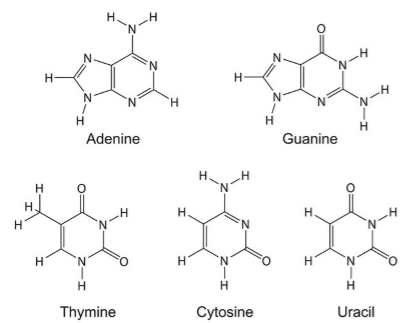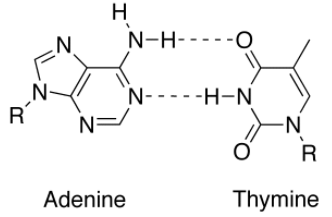
Adenine pairs with Thymine through:
A) Two hydrogen bonds
B) One hydrogen bond
C) Three hydrogen bonds
D) Four hydrogen bonds
Answer
484.8k+ views
Hint: Adenine and Thymine are the nitrogenous bases that are found attached with the pentose sugar in Nucleic Acids. In DNA, there are four nitrogenous bases found called Adenine, Thymine, Guanine and Cytosine. However, in RNA, Thymine is replaced with another Nitrogenous base called Uracil.
Complete answer:
Nucleic acids can be considered as the polymers of Nucleotides, where each nucleotide is basically a pentose sugar (Ribose in case of RNA and Deoxyribose in case of DNA) attached with a Nitrogenous base and a Phosphate group. These nucleotides are attached to each other by means of Phophodiester bonds.
There are two types of Nitrogenous bases that are found in the nucleic acids. These are: Purines and Pyrimidines. Adenine and Guanine are Purines while Thymine, Uracil and Cytosine are Pyrimidines. There structures are best shown as:

Nitrogenous bases attached to the pentose sugar alone (no phosphate group attached) are called Nucleosides.
Once the nucleotides polymerise, they form a long chain of nucleic acid. Two such long chains with complementary bases present opposite to each other get bonded with the help of hydrogen bonds between the complementary nitrogen bases to form a double stranded structure.
Adenine always forms two hydrogen bonds with Thymine (in case of DNA) and Uracil (in case of RNA) while Cytosine always forms three hydrogen bonds with Guanine.
This can be easily understood with the following diagram:

So, the correct answer would be option (A).
Note: Students generally get confused between the idea of Nucleotide and Nucleoside. Always remember, a nucleoside along with a phosphate group is called a nucleotide. Nucleotide is composed of a nitrogenous base and a phosphate group.
Complete answer:
Nucleic acids can be considered as the polymers of Nucleotides, where each nucleotide is basically a pentose sugar (Ribose in case of RNA and Deoxyribose in case of DNA) attached with a Nitrogenous base and a Phosphate group. These nucleotides are attached to each other by means of Phophodiester bonds.
There are two types of Nitrogenous bases that are found in the nucleic acids. These are: Purines and Pyrimidines. Adenine and Guanine are Purines while Thymine, Uracil and Cytosine are Pyrimidines. There structures are best shown as:

Nitrogenous bases attached to the pentose sugar alone (no phosphate group attached) are called Nucleosides.
Once the nucleotides polymerise, they form a long chain of nucleic acid. Two such long chains with complementary bases present opposite to each other get bonded with the help of hydrogen bonds between the complementary nitrogen bases to form a double stranded structure.
Adenine always forms two hydrogen bonds with Thymine (in case of DNA) and Uracil (in case of RNA) while Cytosine always forms three hydrogen bonds with Guanine.
This can be easily understood with the following diagram:

So, the correct answer would be option (A).
Note: Students generally get confused between the idea of Nucleotide and Nucleoside. Always remember, a nucleoside along with a phosphate group is called a nucleotide. Nucleotide is composed of a nitrogenous base and a phosphate group.
Recently Updated Pages
Express the following as a fraction and simplify a class 7 maths CBSE

The length and width of a rectangle are in ratio of class 7 maths CBSE

The ratio of the income to the expenditure of a family class 7 maths CBSE

How do you write 025 million in scientific notatio class 7 maths CBSE

How do you convert 295 meters per second to kilometers class 7 maths CBSE

Write the following in Roman numerals 25819 class 7 maths CBSE

Trending doubts
Give 10 examples of unisexual and bisexual flowers

Draw a labelled sketch of the human eye class 12 physics CBSE

Differentiate between homogeneous and heterogeneous class 12 chemistry CBSE

Differentiate between insitu conservation and exsitu class 12 biology CBSE

What are the major means of transport Explain each class 12 social science CBSE

Franz thinks Will they make them sing in German even class 12 english CBSE




